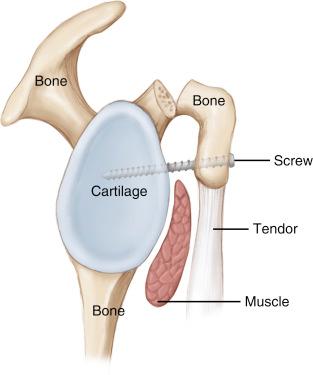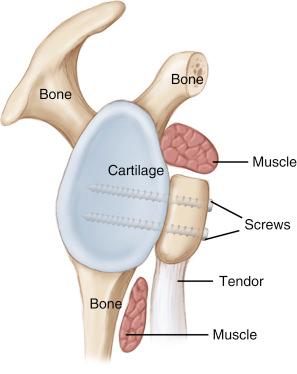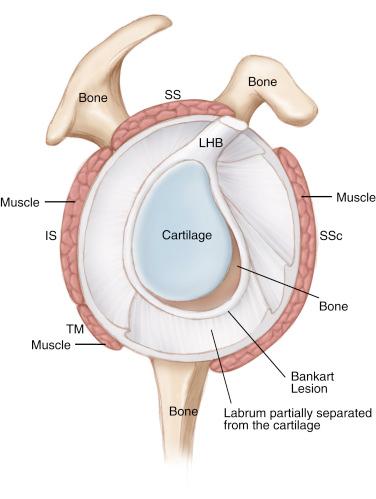Physical Address
304 North Cardinal St.
Dorchester Center, MA 02124
The shoulder is the least constrained and most mobile joint, making instability a frequent condition in a young and active population. The rotator cuff creates a concavity compression mechanism that dynamically stabilizes the shoulder. Rotator cuff tear favors instability, and therefore the association of both pathologies should be researched even after a single dislocation. Treatment options include nonoperative and operative management. Careful evaluation should precede the surgeon’s decision.
Anterior stabilization and rotator cuff repair is proposed to patients with associated capsulolabral lesions (Bankart, anterior labral periosteal sleeve avulsion) and rotator cuff tear. Arthroscopic Bankart repair and double-row rotator cuff repair (suture bridge technique) are described below.
Age over 40 years
Overhead throwing or contact sports athletes
Remaining shoulder pain after dislocation
Loss of active motion and/or weakness after dislocation
Recurrence of instability despite good initial management
Check for amyotrophy of the deltoid, supraspinatus, and infraspinatus muscles.
Note passive and active mobilities in order to eliminate adhesive capsulitis.
Rotator cuff tears test is positive:
In case of subscapularis tear: increased passive external rotation compared with the other shoulder, positive lift-off and bear-hug tests. Results of biceps tests such as the O’Brien test may be positive in case of long head of the biceps dislocation.
In case of posterosuperior tear: positive Jobe empty can test result, external rotation lag sign.
Hyperlaxity might be present with external rotation greater than 85 degrees.
Anteroinferior glenohumeral laxity with a positive Gagey hyperabduction test result.
Instability is assessed with an anterior and inferior apprehension sign and positive relocation test result.
Search for biceps tendon disorders and superior labrum anterior and posterior tears that might be associated: positive lift-off, Speed and O’Brien tests.
Check neurologic status of the axillary nerve and deltoid function (the terrible triad of the shoulder with labral tear, rotator cuff tendon tear, and axillary nerve injury is frequent in contact sports).
Anteroposterior radiographs in internal, neutral, and external rotation and comparative Bernageau views will be used to look for superior humeral head migration, arthritis, Hill-Sachs lesion (especially in internal rotation to evaluate the ratio of notch depth to humeral head radius) and glenoid bone loss or fracture such as a bony Bankart lesion. Comparative views are helpful to show lesions of the anteroinferior glenoid rim.
The cuff tears are best characterized with magnetic resonance imaging (MRI) scans or computed tomographic arthrograms (CTAs). Ultrasound is very helpful when a cuff tendon tear is suspected, but an MRI scan or CTA is necessary before surgical repair. The surgeon will note the size of the rupture, the number of tendons involved (most of the time, the supraspinatus muscle or posterosuperior tears with associated infraspinatus tear), a full- or partial-thickness tear, fatty infiltration of the muscle, muscle atrophy, and the condition of the long head of the biceps (LHB).
Capsular and labral lesions will be researched, too: Bankart lesion, ALPSA (anterior labral periosteal sleeve avulsion), or HAGL (humeral avulsion of the glenohumeral ligament).
Electrophysiological examination of the axillary nerve should be performed according to the physical examination or in case of revision surgery.
Nonoperative treatment with physiotherapy in low-demand patients gives worse results for pain and mobility than surgical treatment.
Rotator cuff repair alone is preferred when no instability lesion is identified on the preoperative imaging studies. Careful arthroscopic examination should eliminate any lesion of the capsulolabral complex.
Repair of the subscapularis muscle when torn with associated instability offers good results for stability and pain but inconstant results for mobility. The modality of the repair depends on the quality of the remaining muscle in the particular case of revision surgery. Transosseous sutures or suture anchor reinsertion is possible when the muscle is of good quality (little retraction, low fatty infiltration). Nevertheless, one should never exclude the possibility of performing a split pectoralis major transfer.
Stabilization alone is advocated in case of massive or irreparable tears with an intact subscapularis muscle. The Trillat intervention ( Fig. 27.1 ) lowers and medializes the coracoid process. The coracoid fragment is fixed to the glenoid neck. It improves glenohumeral stability and lessens external rotation by lowering the subscapularis muscle. This procedure can be performed arthroscopically but is contraindicated in case of major Hill-Sachs lesions or glenoid erosion. The Latarjet procedure ( Fig. 27.2 ) or Hill-Sachs remplissage should be preferred in these cases.


In case of a reparable cuff tear associated with a labral lesion, a combined procedure should be performed. It associates labral and rotator cuff repair.
A reverse shoulder arthroplasty should be preferred in case of associated osteoarthritis.
Labrum
Rotator interval
Supraspinatus tendon
Infraspinatus tendon
Subscapularis tendon
Young or demanding patient with persistent shoulder pain and/or weakness
Recurrence of instability or positive apprehension test
Repairable tear or PASTA (partial articular side tendon avulsion) lesion
Labral tear such as a Bankart lesion ( Fig. 27.3 )

No axillary palsy or glenohumeral osteoarthritis
Become a Clinical Tree membership for Full access and enjoy Unlimited articles
If you are a member. Log in here